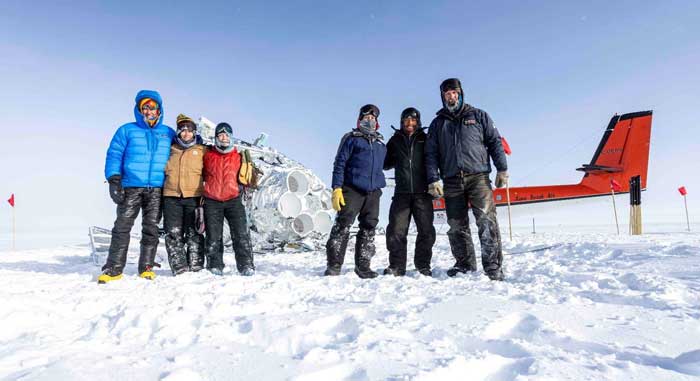
The first crew of Polies and SPIDER project team members at the SPIDER balloon landing site near Hercules Dome on 21 January, to recover priority items including stored data and critical electronics. Photo: Kelsey Kushneryk.
 For a number of years, large scientific balloons have been launched from the LDB facility at McMurdo, on various projects sponsored by NASA and its Columbia Scientific Balloon Facility (CSBF). This season's project, SPIDER-2 (Suborbital Polarimeter for Inflation, Dust, and the Epoch of Reionization) had originally been scheduled for 2019-20 but was postponed due to a lack of space on the ice...and postponed again the next two seasons due to the COVID-19 pandemic. A previous version of the project, SPIDER-1, had been successfully launched from McMurdo on 1 January 2015. The 2022-23 project team members came from a number of different institutions, with principal investigator (PI) Jeff Filippini from the University of Illinois Urbana-Champaign. The deployment of some of the team members was significantly delayed, as just before Jeff and other team members were scheduled to fly to McMurdo, NSF instituted a 2-week pause in travel due to a significant COVID-19 outbreak. But the team members already on the ice kept the project on schedule. Here's the project information page from the USAP Science Planning Summary. The balloon was launched on 22 December and was brought to earth on 7 January after just over 16 days of flight time. For a number of years, large scientific balloons have been launched from the LDB facility at McMurdo, on various projects sponsored by NASA and its Columbia Scientific Balloon Facility (CSBF). This season's project, SPIDER-2 (Suborbital Polarimeter for Inflation, Dust, and the Epoch of Reionization) had originally been scheduled for 2019-20 but was postponed due to a lack of space on the ice...and postponed again the next two seasons due to the COVID-19 pandemic. A previous version of the project, SPIDER-1, had been successfully launched from McMurdo on 1 January 2015. The 2022-23 project team members came from a number of different institutions, with principal investigator (PI) Jeff Filippini from the University of Illinois Urbana-Champaign. The deployment of some of the team members was significantly delayed, as just before Jeff and other team members were scheduled to fly to McMurdo, NSF instituted a 2-week pause in travel due to a significant COVID-19 outbreak. But the team members already on the ice kept the project on schedule. Here's the project information page from the USAP Science Planning Summary. The balloon was launched on 22 December and was brought to earth on 7 January after just over 16 days of flight time.
The heart of the project is a cryostat ("thermos bottle") holding six microwave receivers (telescopes)--three at 280 GHZ, two at 90 GHZ, and one at 150 GHZ (the 2015 launch had included 3 150 GHZ abd 3 90 GHZ receivers). They were cooled from a 1300 l tank of liquid helium. The receivers looked at cosmic microwave background radiation from the very beginnings of the universe. At above left, the back of the cryostat with two of the telescopes loaded and one more awaiting installation (Jared May/JF). Below, two more photos of the assembly process. |
 Cryostat lifting onto gondola (JF/Jared May) |
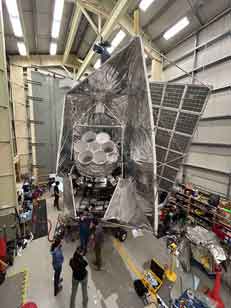 The payload in the high bay with sunshield (JF). |
|
The instrument was much too large to be shipped assembled, so it had to be put together on site. At left above, SPIDER is supported by a carbon fiber frame which includes drive mechanisms for aiming the instruments. At right is the nearly fully assembled package, which included a carbon fiber frame, a sun shield, satellite antennas for communications, cone baffles on the six receivers, and a large solar panel assembly to supply the 2 kW of power needed to power the instrument. The entire unit weighed 3 tons. Here's a photo of the fully assembled instrument and most of the project team shortly before launch (Scott Bataion (CSBF)/JF).
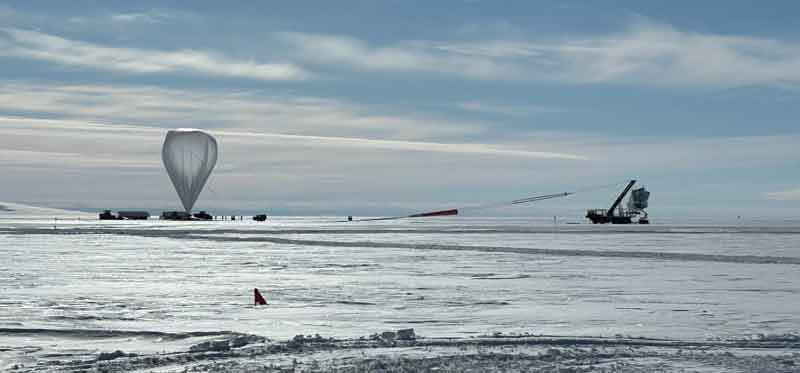
SPIDER on the flight line just before launch...balloon, parachute, launch vehicle, payload (Steve Benton/JF).
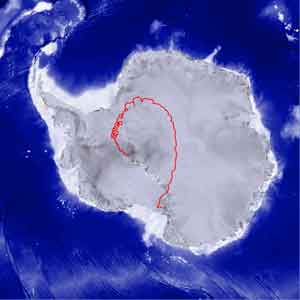 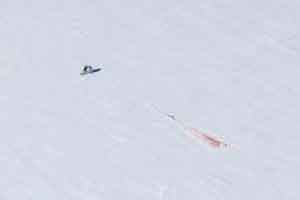
Just over 16 days after launch, after traveling 20 miles above the ice, the flight was terminated at 1713 SP time on 7 January. The decision was made to end the flight when the balloon was over terrain that was favorable for recovery. That turned out to be about 270 miles from Pole at 86º7.82'S-101º27.49'W, near the Hercules Dome field camp which was also being supported out of Pole. At left is the tracking plot from the CSBF web site. And at right, a photo taken from the air of SPIDER on the ice, by KBA pilot Kelsey Kushneryk (JF). The first recovery flight from Pole happened on 21 January as depicted in the photo at the top of this page.
|
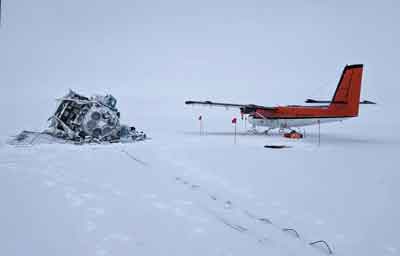 The first recovery flight, a Twin Otter, next to the payload (Scott Battaion/JF) |
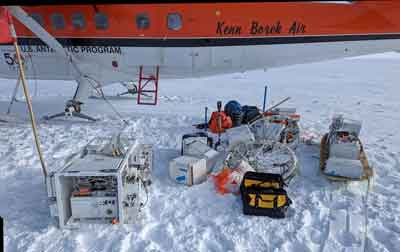 The high priority disk storage drives and other cargo recovered on the first flight (Scott Battaion/JF). |
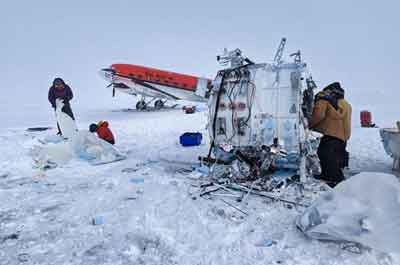 Another recovery flight, this time there were two aircraft--this Basler (pictured) as well as a Twin Otter. Folks are tearing into the payload to recover the good stuff. (Scott Battaion//UIUCphysics) |
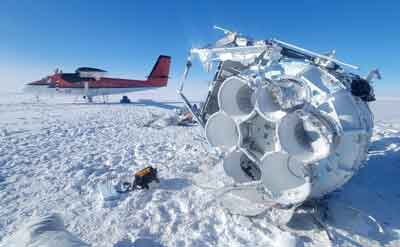 Here's a Twin Otter on one of the recovery flights (Luke Haberkern). The payload had to be cut up into pieces small enough to fit on the recovery aircraft. |
|
There were a total of 4 recovery flights...two visits by a Twin Otter alone, and a joint visit with both a Twin Otter and a Basler with a large recovery team.
The payload, parachute, and associated NASA hardware were recovered...the balloon, which landed several miles away, was not recovered.
More information as well as a video of the launch...see this this 6 March Antarctic Sun article. The photos labeled JF are from PI jeff Filippini's blog which contains many more details and photos about the project. Jeff has also shared additional information with me, including the photographer identification of photos taken by other SPIDER team members which I've referenced thanks to Jeff. The photo labeled UIUCphysics is from the University of Illinois physics department page about the project--that page also includes more info and photos. The photos by Kelsey Kushneryk and Luke Haberkern were shared on South Pole weekly sitreps.
|










